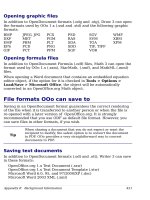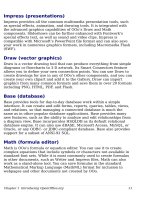Getting Started with Open Office .org 3 part 10 pptx
Bạn đang xem bản rút gọn của tài liệu. Xem và tải ngay bản đầy đủ của tài liệu tại đây (4.77 MB, 10 trang )
Inserting special characters
A
special character
is one not found on a standard English keyboard.
For example, © ¾ æ ç ñ ö ø ¢ are all special characters. To insert a
special character:
1) Place the cursor where you want the character to appear.
2) Click Insert > Special Character to open the Special
Characters window (Figure 63).
3) Select the characters you wish to insert, in order, then click OK.
The selected characters are shown in the lower left of the dialog.
As you select a character, it is shown on the lower right, along
with its numerical code.
Note
Different fonts include different special characters. If you do
not find a particular special character, try changing the
Font
selection.
Figure 63: The Special Characters window,
where you can insert special characters.
Tip
Notice that the characters selected appear in the bottom-left
corner of the window.
Setting tab stops and indents
The horizontal ruler shows both the default tab stops and any that you
have defined. To set the measurement unit and the spacing of default
tab stops, go to Tools > Options > OpenOffice.org Writer >
General.
You can also set or change the measurement unit by right-clicking on
the ruler to open a list of units, as shown in Figure 64. Click on one of
them to change the ruler to that unit.
Chapter 4 Getting Started with Writer 91
Figure 64: Ruler showing default tab stops
Double-click on a blank part of the ruler to open the Indents & Spacing
page of the Paragraph dialog. Double-click on the ruler itself to open
the Tabs page of the Paragraph dialog (Figure 65) and fine-tune tab
stop settings.
Figure 65: The Tabs page of the Paragraph dialog
Checking spelling
Writer provides a spelling checker, which can be used in two ways.
AutoSpellcheck checks each word as it is typed and displays a
wavy red line under any misspelled words. When the word is
corrected, the line disappears.
To perform a separate spelling check on the document (or a text
selection) click the Spellcheck button. This checks the document
or selection and opens the Spellcheck dialog if any misspelled
words are found.
92 Getting Started with OpenOffice.org 3
Here are some more features of the spelling checker:
• Right-click on a word with a wavy underline to open a menu. If
you select from the suggested words on the menu, the selection
will replace the misspelled word in your text.
• You can change the dictionary language (for example, to Spanish,
French or German) on the Spellcheck dialog.
• You can add a word to the dictionary. Click Add in the Spellcheck
dialog and pick the dictionary to add it to.
• The Options dialog of the Spellcheck tool has a number of
different options such as whether to check uppercase words and
words with numbers. It also allows you to manage custom
dictionaries, that is, add or delete dictionaries, and add or delete
words in a dictionary.
• On the Font tab of the Paragraph Styles dialog, you can set
paragraphs to be checked in a specific language (different from
the rest of the document). See Chapter 7 (Working with Styles) in
the
Writer Guide
for more information.
Using language tools
OOo provides some tools that make your work easier if you mix
multiple languages within the same document or write documents in
various languages.
You can set the language for the whole document, selected paragraphs,
or even individual words or characters. In versions earlier than OOo
3.0 it was necessary to use styles in order to insert within a document
paragraphs or individual groups of characters that use a different
language, while now this can be conveniently done from the main
menu.
Tip
Using character and paragraph styles is still the preferred
method, as styles allow a greater level of control and make
changing the language much faster. See Chapter 7 (Working
with Styles) in the
Writer Guide
for information on how to
manage the language settings of a style.
The main advantage of changing the language is that you can then use
the correct dictionaries to check spelling and apply the localized
versions of Autocorrect replacement tables, thesaurus, and
hyphenation rules.
The language tools can be found in Tools > Languages on the main
menu, as shown in Figure 66.
Chapter 4 Getting Started with Writer 93
Figure 66: The Language menu
The following options are available:
• For selection: select this option to apply a specified language to
the selected text (the selection can comprise only a few
characters or several paragraphs).
• For paragraph: select this option to apply the specified language
to the paragraph where the cursor is located.
• For all text: select this option to apply the specified language to
all the document.
An alternative way to change the language of a whole document is to
use Tools > Options > Language Settings > Languages. In the
Default languages for documents
section of the Options dialog (Figure
67), you can choose a different language for all the text.
Caution
Unlike the menu tool that applies to the individual document,
a change in the default language from the Options dialog is
a general change of settings of OOo and will therefore apply
to all the documents created in the future. If you want to
change the language for the current document only, be sure
to select the
For the current document only
option.
Spell checking is available only for those languages in the list that have
the symbol next to them. If you do not see the symbol next to your
preferred language, you can install the additional dictionary using
Tools > Languages > More dictionaries online.
Figure 67: Options available in the Languages settings
94 Getting Started with OpenOffice.org 3
The language used for checking spelling is also shown in the status
bar, next to the page style in use.
You can also configure the language for a paragraph or a group of
characters as None. This option is particularly useful in the case
where you insert in the document text that you do not want to
spellcheck, such as web addresses or programming language snippets.
Using AutoCorrect
Writer’s AutoCorrect function has a long list of common misspellings
and typing errors, which it corrects automatically. For example, “hte”
will be changed to “the”. Select Tools > AutoCorrect to open the
AutoCorrect dialog. There you can define which strings of text are
corrected and how. In most cases, the defaults are fine.
Tip
AutoCorrect is turned on by default. To turn it off, uncheck
Format > AutoFormat > While Typing.
To stop Writer from replacing a specific spelling, use Tools >
AutoCorrect > Replace, highlight the word pair and click Delete.
To add a new spelling to correct, type it into the
Replace
and
With
boxes and click New.
See the different tabs of the dialog for the wide variety of other options
available to fine-tune AutoCorrect.
Tip
AutoCorrect can be used as a quick way to insert special
characters. For example, (c) will be autocorrected to ©. You
can add your own special characters.
Using word completion
If Word Completion is enabled, Writer tries to guess which word you
are typing and offers to complete the word for you. To accept the
suggestion, press
Enter
. Otherwise continue typing.
Tip
Many people prefer not to use Word Completion. If you do not
want to use it, select Tools > AutoCorrect > Word
Completion and uncheck
Enable Word Completion
.
Chapter 4 Getting Started with Writer 95
You can customize word completion from the Tools > AutoCorrect >
Word Completion page:
• Add (append) a space automatically after an accepted word.
• Show the suggested word as a tip (hovering over the word) rather
than completing the text as you type.
• Change the maximum number of words remembered for word
completion and the length of the smallest words to be
remembered.
• Delete specific entries from the word completion list.
• Change the key that accepts a suggested entry—the options are
Right arrow
,
End
key,
Return
(
Enter
), and
Space bar
.
Note
Automatic word completion only occurs after you type a word
for the second time in a document.
Using AutoText
AutoText allows you to assign text, tables, graphics and other items to
a key combination. For example, rather than typing “Senior
Management” every time you use that phrase, you might just type “sm”
and press
F3
. Or you can save a formatted Note (like the one on this
page) as AutoText and then insert a copy by typing “note” and pressing
F3
.
To assign some text to an AutoText shortcut:
1) Type the text into your document.
2) Select the text so it is highlighted.
3) Select Edit > AutoText (or press
Control+F3
).
4) Enter a name for your shortcut. Writer will suggest a one-letter
shortcut, which you can change.
5) Click the AutoText button on the right and select New (text
only) from the menu.
6) Click Close to return to your document.
Tip
If the only option under the AutoText button is Import, either
you have not entered a name for your AutoText or there is no
text selected in the document.
AutoText is especially powerful when assigned to fields. See Chapter
14 (Working with Fields) in the
Writer Guide
for more information.
96 Getting Started with OpenOffice.org 3
Inserting dashes and non-breaking spaces
You can insert a dash by using the Special Characters window or by
using AutoCorrect. For more about AutoCorrect, see “Controlling
OOO’s AutoCorrect functions” in Chapter 2 (Setting up
OpenOffice.org) and “Using AutoCorrect” on page 95 in this chapter.
– is an en-dash; that is, a dash the width of the letter “n” in the font
you are using. It is U+2013 (scroll down to the
General
Punctuation
section in the Special Characters window). To enter
an en-dash using AutoCorrect, type at least one character, a
space, one or two hyphens, another space, and at least one more
letter, then a space. The one or two hyphens will be replaced by
an en-dash.
— is an em-dash; that is, a dash the width of the letter “m” in the
font you are using. It is U+2014. To enter it using AutoCorrect,
type at least one character, two hyphens, and at least one more
character, then a space. The two hyphens will be replaced by an
em-dash.
To insert a non-breaking space (to keep characters together, for
example in a telephone number), press
Control+Space
on the
keyboard.
Formatting text
Using styles
Styles are central to using Writer. Styles enable you to easily format
your document consistently, and to change the format with minimal
effort. Often, when you format your document in Writer, you are using
styles whether you realize it or not. A style is a named set of formatting
options. Writer defines several types of styles, for different types of
elements: characters, paragraphs, pages, frames, and lists. See
Chapter 3 (Using Styles and Templates).
Formatting paragraphs
You can apply many formats to paragraphs using the buttons on the
Formatting toolbar. Figure 68 shows the Formatting toolbar as a
floating toolbar, customized to show only the buttons for paragraph
formatting. The appearance of the icons may vary with your operating
Chapter 4 Getting Started with Writer 97
system and the selection of icon size and style in Tools > Options >
OpenOffice.org > View.
Tip
It is highly recommended that you use
paragraph styles
rather
than manually formatting paragraphs, especially for long or
standardized documents. For information on the advantages of
styles, and how to use them, see Chapter 13 (Working with
Styles) in this book and Chapters 6 and 7 in the
Writer Guide
.
1 Open Styles and
Formatting Window
5 Align Right 10 Numbering On/Off
6 Justified 11 Bullets On/Off
2 Apply Style 7 Line Spacing: 1 12 Decrease Indent
3 Align Left 8 Line Spacing: 1.5 13 Increase Indent
4 Centered 9 Line Spacing: 2 14 Paragraph format dialog
Figure 68: The Formatting toolbar, showing icons for
paragraph formatting.
Figure 69 shows examples of the different alignment options.
Figure 69: Different text alignment options.
Formatting characters
You can apply many formats to characters using the buttons on the
Formatting toolbar. Figure 70 shows the Formatting toolbar as a
floating toolbar, customized to show only the buttons for character
formatting.
Tip
It is highly recommended that you use
character styles
rather
than manually formatting characters. For information on the
advantages of styles, and how to use them, see Chapter 6
(Introduction to Styles) in the
Writer Guide
.
98 Getting Started with OpenOffice.org 3
The appearance of the icons may vary with your operating system and
the selection of icon size and style in Tools > Options >
OpenOffice.org > View.
1 Open Styles and
Formatting Window
6 Italic 12 Font Color
7 Underline 13 Highlighting
2 Apply Style 8 Superscript 14 Background Color
3 Font Name 9 Subscript 15 Open Character
Format Dialog
4 Font Size 10 Increase Font
5 Bold 11 Reduce Font
Figure 70: The Formatting toolbar, showing icons for
character formatting
Tip
To remove manual formatting, select the text and click Format
> Default Formatting, or right-click and select Default
Formatting.
Autoformatting
You can set Writer to automatically format parts of a document
according to the choices made on the Options page of the AutoCorrect
dialog (Tools > AutoCorrect > Options).
Tip
If you notice unexpected formatting changes occurring in your
document, this is the first place to look for the cause.
Some common unwanted or unexpected formatting changes include:
• Horizontal lines. If you type three or more hyphens ( ),
underscores (___) or equal signs (===) on a line and then press
Enter
, the paragraph is replaced by a horizontal line as wide as
the page. The line is actually the lower border of the preceding
paragraph.
• Bulleted and numbered lists. A bulleted list is created when you
type a hyphen (-), star (*), or plus sign (+), followed by a space or
tab at the beginning of a paragraph. A numbered list is created
when you type a number followed by a period (.), followed by a
space or tab at the beginning of a paragraph. Automatic
numbering is only applied to paragraphs formatted with the
Default
,
Text body
or Text body indent paragraph styles.
Chapter 4 Getting Started with Writer 99
To turn autoformatting on or off, go to Format > AutoFormat and
select or delete the items on the sub menu.
Creating numbered or bulleted lists
There are several ways to create numbered or bulleted lists:
• Use autoformatting, as described above.
• Use list (numbering) styles, as described in Chapters 6
(Introduction to Styles) and 7 (Working with Styles) in the
Writer
Guide
.
• Use the Numbering and Bullets icons on the paragraph
formatting toolbar (see Figure 68). This method is described here.
To produce a numbered or bulleted list, select the paragraphs in the
list, and then click the appropriate icon on the toolbar.
Note
It is a matter of personal preference whether you type your
information first, then apply Numbering/Bullets, or apply them
as you type.
Using the Bullets and Numbering toolbar
You can create nested lists (where one or more list items has a sublist
under it, as in an outline) by using the buttons on the Bullets and
Numbering toolbar (Figure 71). You can move items up or down the
list, or create subpoints, and even change the style of bullets. Use
View > Toolbars > Bullets and Numbering to see the toolbar.
The appearance of the icons may vary with your operating system and
the selection of icon size and style in Tools > Options >
OpenOffice.org > View.
1 Bullets On/Off 6 Move Up (One Level) with
Sub-points
10 Move Down
2 Numbering On/Off 11 Move Up in Sub-points
3 Numbering Off 7 Move Down (One Level)
with Sub-points
12 Move Down in Sub-points
4 Up One Level 8 Insert Unnumbered Entry 13 Restart Numbering
5 Up One Level 9 Move Up 14 Bullets and Numbering
Figure 71: Bullets and Numbering toolbar
100 Getting Started with OpenOffice.org 3









